1. INTRODUCTION
Swinging a racquet is a process that is not easy to describe in words since the actions of all the various body segments are quite complicated. However, if we focus just on the forearm and the racquet then the task is a little easier, especially since these two segments by themselves act like a double pendulum. A double pendulum is just two single pendulums joined end to end. To illustrate the point, consider the two film clips shown below where the action of the arm and racquet in a serve is compared with a simple mechanical double pendulum. Both were filmed in slow motion, at 300 fps, to observe the action more clearly. The pendulum version is upside-down, but the actions are very similar.
Movie 1
Pendulum Motion of the Serve
Movie Screen 1. — Double Pendulum Motion in the serve.
(Note: Movies are best viewed frame by frame using keyboard arrow keys or movie controls.)
Movie Screen 2. — The difference in racquet and forearm speed between a light "racquet" and a heavy racquet.
(Note: Movies are best viewed frame-by-frame using keyboard arrow keys or movie controls.)
The server struck the ball at 100 mph so the racquet swung much faster than the mechanical pendulum. The mechanical pendulum was constructed using a sawn-off baseball bat as a forearm and a long wood dowel as a racquet, connected by an artificial wrist joint consisting of two eye hooks held together loosely with a small bolt. There is no wrist or elbow action in the mechanical pendulum, and gravity alone caused the pendulum to rotate. Even so, the similarity with a real serve is remarkable. With a few extra modifications to the pendulum, it could be made to behave just like a real serve. It needs only a bit of elbow action and a bit of wrist action to behave in a more realistic manner.
Several things stand out. One is that the forearm slows down while the racquet speeds up. Another is that the racquet rotates through a larger angle than the forearm. The forearm and racquet start out at right angles and end up almost in line by the time the racquet strikes the ball. In a real serve, the forearm and racquet remain at right angles for about 80% of the swing time. In the pendulum swing, the dowel drops straight down before it starts to swing around, because there is no wrist to lock the dowel at right angles to the forearm. We could ask several questions about this. Is it actually necessary to lock the wrist at the start of a serve? Does the wrist rotate the racquet at the end of the swing or is it the other way around? That is, does the racquet rotate the wrist? Would it help if the forearm didn't slow down? These sorts of questions are easily answered by looking at the mechanics of a pendulum, especially when we add some artificial elbow and wrist action.
The actions of a double pendulum have been studied for many years, especially in relation to the swing of a golf club. The physics of swinging a tennis racquet has not been studied in nearly as much detail. Part of the problem is that there are many different ways of swinging a racquet. A golfer has a simpler task since the ball just sits there waiting to be struck and the golfer needs only to hit the ball toward the hole. Except when serving, a tennis player needs to chase down the ball and then hit it from a range of different heights to various parts of the court, either using a forehand or a backhand or a volley or a half-volley or a smash. Golfers only ever hit the ball with backspin, but tennis players can hit the ball with topspin or backspin or side spin or any other spin they like.
In tennis, the wrist is not just a passive hinge, like it is in a mechanical double pendulum, but plays an active role in controlling the racquet. Similarly, the elbow joint is not passive, but plays an active role in controlling motion of the forearm. The beauty and the complication of this arrangement is that motion of the forearm affects motion of the racquet, and motion of the racquet affects motion of the forearm, so the two cannot be controlled separately or independently. The results are sometimes unexpected but are consistent with the way that a double pendulum behaves.
If the wrist is completely limp, then the player has no direct control over the racquet and the racquet will just swing where it wants to swing. In general, the player rotates the forearm at a controlled speed, using muscles in the upper arm, and uses the wrist as an extra aid to control exactly where the racquet needs to go. If the wrist is locked then the forearm and the racquet behave as a single, solid object and both rotate at the same speed. That is, if the forearm rotates through say 30 degrees, then so does the racquet. The rotation speeds (measured in degrees per second) of the forearm and the racquet are the same even though the actual speed of the racquet (measured in mph or feet per second) is greater than the actual speed of the forearm.
The complex interaction between the forearm and the racquet is nicely described in terms of the physics of a double pendulum. Players don't worry about that since they know from experience what happens to the racquet when they swing their arm or use their wrist to position the racquet. However, they may not be aware of some of the fine details. For example, a surprising feature is that the forearm slows down rapidly just before a player strikes the ball. The forearm speeds up at the start of the swing but the main object of the exercise is to swing the racquet rather than the forearm. The best way to do that is to allow the forearm to slow down just before striking the ball so that the forearm transfers its energy to the racquet. In fact, there is a whole chain of events involved in swinging a racquet. Before the forearm slows down, the upper arm slows down to transfer its energy to the forearm. And before that, the upper torso slows down to transfer its energy to the upper arm.
It is difficult for a player to predict how the swing will change if the player uses a different racquet or the racquet is modified in some way by adding weight to the tip or the handle. But the changes can be predicted using a double pendulum calculation. Similarly, one can predict what will happen if the player uses more wrist action or deliberately swings the forearm faster.
In this article we will consider only a forehand and a serve, the object of the exercise being to see what insights can be gained by treating the forearm and the racquet as a double pendulum. The particular advantage of this approach is that it is easy to calculate the effect of different wrist and elbow actions. It is much harder to measure the effects. I admit that the calculations ignore several real effects, but the basic double pendulum action is obvious from the video film.
2. WALKING AND RUNNING
As an aside, it is worth mentioning that the action of a double pendulum can be seen in many different human activities, not just in swinging a racquet or a golf club. The best known examples are walking and running. The upper leg is swung by muscles around the hip and the lower leg is swung by muscles around the knee. Walking and running involve two double pendulums working in unison. Success requires that each segment be swung at the right time, at the right speed, and by the right amount. Movie Screen 3 shows the double pendulum action involved in walking.
Double Pendulum Motion While Walking
Movie Screen 3. — Double pendulum motion while walking.
(Note: Movies are best viewed frame by frame using keyboard arrow keys or movie controls.)
3. SERVE DATA
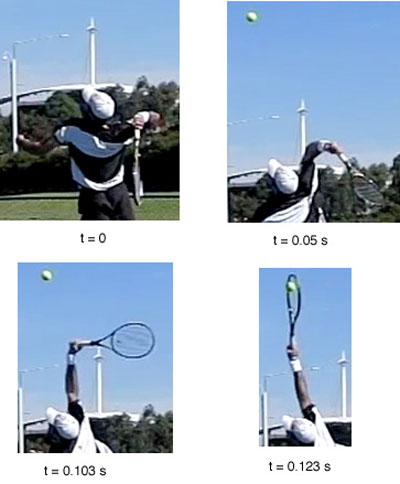
Figure 1 — Positions of racquet and forearm viewed from the side.
The serve data in from the video in Movie Screen 1 provides a good basis for further calculations, although a direct comparison with a double pendulum is not straightforward. The main problem is that the serve action occurs in all three dimensions, whereas a double pendulum normally swings in just one plane. Another problem is that the upper arm, forearm and racquet together form a triple rather than a double pendulum. In effect, the upper arm and forearm form one double pendulum, while the forearm and racquet form another double pendulum. The serve action is shown in Figs. 1 and 2 and can be divided into three stages. In Stage 1, the upper arm reaches maximum speed. In Stage 2, the forearm reaches maximum speed. In Stage 3, the racquet reaches maximum speed.
Stage 1: t = 0 to t = 0.05 s. The upper arm swings from an approximately horizontal position to a vertical position while the forearm remains horizontal and remains locked at right angles to the upper arm. The racquet remains locked at right angles to the forearm. Since the forearm has not yet started to rotate in the vertical plane, this stage of the serve action is not part of the double pendulum involving the forearm and the racquet.
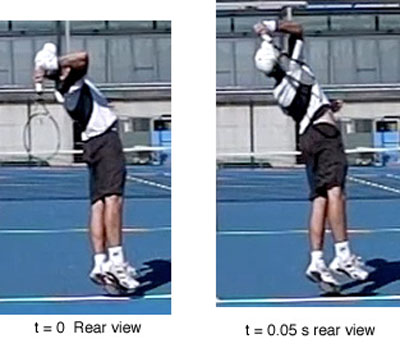
Figure 2 — Positions of racquet, forearm and upper arm viewed from the rear.
Stage 2: t = 0.05 to t = 0.103 s. The upper arm remains approximately vertical while the forearm swings from a horizontal to a vertical position. The racquet remains locked at right angles to the forearm so the racquet and the forearm both rotate at the same speed. This is the start of the double pendulum motion, analogous to the start of the swing of a golf club where the club is locked at right angles to the arms. Since the forearm and the racquet both rotate through 90 degrees in 0.053 seconds, the average rotation speed of each segment is 90/0.053 = 1700 degrees/sec or 4.72 rev/sec or 283 rpm.
Stage 3: t = 0.103 to t = 0.123 s. The forearm rotates forward about 10 degrees while the racquet rotates through 90 degrees. This is the final stage of the double pendulum action where the wrist unlocks to allow the racquet to rotate as fast as possible. The average rotation speed of the forearm is 10/0.02 = 500 deg/s = 1.4 rev/s = 83 rpm and the average rotation speed of the racquet is 90/0.02 = 4500 deg/s = 12.5 rev/s = 750 rpm. Just before impacting with the ball, the racquet was actually rotating at close to 6000 deg/s = 1000 rpm.
Because of the three-dimensional nature of the serve, it is difficult to track accurately the rotation speed of the forearm and the racquet through the entire swing. However, we can use the average speeds of the forearm and the racquet to construct a reasonable two-dimensional model of the process. Two models could be considered. One starting at t = 0 and ending at t = 0.103 s would describe the double pendulum action of the upper arm and forearm. During this time, the racquet is simply an extra mass in the hand, locked at right angles to the forearm. The other model, starting at t = 0.05 s and ending at t = 0.123 s, is the one we will consider in more detail. During this time the upper arm does not rotate by any significant amount but the elbow moves upward and forward due to motion of the whole body.
One extra piece of information needed to analyze the serve is the elbow speed, shown in Fig. 3. The upper arm and the elbow rotated in a vertical plane. The elbow was rising rapidly at t = 0 and slowed almost to a stop by the time the player struck the ball.
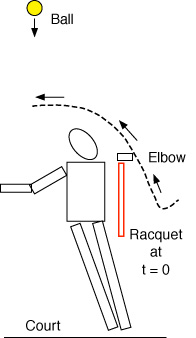
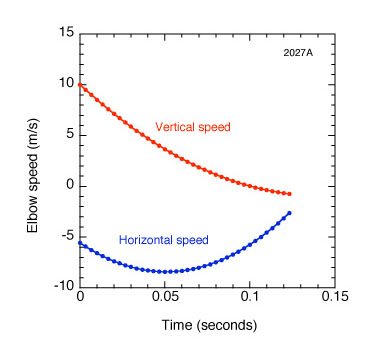
Figure 3 — (a) Path of elbow in video serve (b) Elbow speed in the vertical and horizontal directions. The horizontal speed is negative since the elbow moves from right to left in the video.
4. WRIST ACTION
When a golfer swings a club, the wrist normally relaxes half way through the stroke. In a golf swing, the club head swings around so fast there is very little a player can do with the wrist near the end of the swing to change the swing speed. In effect, the club rotates the wrist, not the other way around.
A tennis racquet has a smaller swing weight than a golf club and can be swung with only one arm. The effect of the wrist on the swing speed might therefore be more significant. We can estimate the effect with a simple calculation. Suppose that a player takes 0.1 sec to accelerate the racquet from 0 to 600 rpm in a serve. 600 revolutions in a minute corresponds to 10 revolutions in one second or one revolution in 0.1 seconds. That is the maximum rotation speed of the racquet. Most pros swing their racquet a bit faster than that in a first serve. The numbers here are typical of a second serve. If it takes 0.1 s to get up to that speed then the torque on the racquet is about 30 Nm or about 22 ft-lbs. Not all of that torque is supplied by the wrist, but some of it might be.
The maximum torque that can be exerted by the wrist can be estimated from a simple experiment. A player can easily hold a racquet in a horizontal position with one hand. If a 1 lb weight is added near the tip of the racquet, say 2 ft from the wrist, then it is harder to hold the racquet in a horizontal position since the extra weight exerts a torque of 2 ft-lbs on the wrist. The wrist needs to exert a torque of 2 ft-lbs on the racquet to stop it rotating. At most, a player might be able to support a 10 lb weight in this way, so the maximum torque that can be exerted by the wrist is about 20 ft-lbs.
Holding a 10 lb weight like this would put a real strain on the wrist, but a player might be able to exert a torque of this magnitude for a split second without straining the wrist too much. In that case, almost all of the torque needed to swing a racquet in a serve could be provided by wrist action. The question is, does a player actually use the wrist in this way or is sufficient torque provided just by rotation of the arm and the body?
Watching a player doesn't answer the question. If the hand is rotating about an axis through the wrist then that doesn't mean the player is using the wrist to rotate the racquet. It might be the other way around. The racquet might be rotating so fast that it causes the hand to rotate. The forearm can also cause the hand to rotate. If you relax your wrist, you can rotate your hand back and forth just by shaking your forearm back and forth. Or you can use your wrist to speed up motion of the hand or to stop your hand flapping around when you shake your forearm. If the forearm is swinging rapidly and suddenly slows down then the hand and the racquet will be flung forward. That is how a double pendulum works and it is how players generate extra speed when swinging a racquet or a golf club.
In theory, it should be possible to estimate the amount of positive or negative wrist action in terms of measured rotation speeds of the racquet and the forearm, but that is difficult to do. As far as I know, nobody has ever done that. An alternative and simpler approach is to examine the mechanics of swinging a racquet to determine how much wrist action is actually needed.
5. LIMP VS LOCKED WRISTS

Figure 4 — At the start of a racquet stroke the wrist can remain limp as in the middle diagram or it can be locked as in the diagram at the right.
Consider the start of a swing where the racquet and the forearm are both at rest or almost at rest. A typical situation is shown in Fig. 4 where the racquet and forearm are at right angles and where the forearm starts to swing forward. Two possible results are shown. One where the wrist remains limp, and the other where the wrist is "locked" as if the racquet and forearm are bolted together. If the wrist remains limp and acts as a simple hinge then the wrist acts only to pull the racquet forward and there is no rotation of the racquet at the start of the swing. If the wrist is locked then the racquet and the forearm both rotate together as a single unit.
When the wrist remains limp there is only one force acting on the racquet and it acts in line with the racquet since that is the direction that the wrist is moving at the start of the swing. If the forearm rotates in a circular arc then the wrist also rotates in a circular arc so the force on the racquet will change direction and then the racquet will start to rotate to follow the path of the wrist. That is what happened to the wood dowel in the video at the start of the swing. That sort of behavior can be seen in some forehand strokes where the forearm rotates faster than the racquet at the start of the swing. It doesn't mean that the wrist is completely limp. It means that the wrist is not working hard enough to keep the racquet locked at a fixed angle to the forearm. As seen below, both Federer and Djokovic do that, so it is not necessarily a bad thing.
Movie Screen 4. — Federer and Djokovic both display the "floppy wrist" at the beginning of the forward motion of the swing.
(Note: Movies are best viewed frame-by-frame using keyboard arrow keys or movie controls.)
(Reference: Courtesy of John Yandell's 'High Speed Stroke Archives' at Tennisplayer.net).
6. TORQUES AND COUPLES
Figure 5 shows four different situations where forces can be applied to the handle of a racquet to rotate the racquet. If the force is applied in a direction along the handle, as in Fig. 5(a) then the racquet will accelerate in a straight line in the direction of the force but the racquet won't rotate. If the racquet is already rotating when a force is applied along the handle in this manner, then the rotation speed won't change since there is no torque on the racquet. In order to apply a torque, the force needs to be directed at an angle to the handle, as in Fig. 5(b). That is what happens soon after the start of the swing when the wrist remains relaxed. The racquet starts to rotate because the wrist starts pulling the handle at an angle to the racquet.
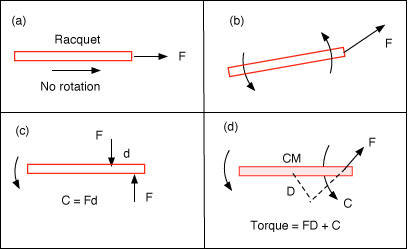
Figure 5 — Forces used to rotate a racquet.
If the wrist alone is used to rotate a racquet, the hand exerts a force along the whole length of the hand. The effect of the hand can be regarded as two separate forces on the handle, as shown in Fig. 5(c). Rotation of the hand exerts a downward force near the first finger and an upward force near the little finger. The two forces are almost equal and opposite but not quite. Two equal and opposite forces acting like this are known as a couple. The magnitude of the couple is given by C = Fd where F is the value of each force and d is the distance between the two forces. The torque acting on the racquet is equal to C. If each force is say 30 lb and d = 4 inch = 1/3 ft then the torque on the racquet is 10 ft-lbs.
More generally, a player will rotate a racquet by exerting a force at an angle to the handle, as in Fig. 5(b), and also by deliberately rotating the hand to apply a couple, as shown in Fig. 5(d). The total torque is then FD + C where D is the perpendicular distance from the center of mass (CM) of the racquet to the line of action of the force. If the acceleration of the racquet is measured and the swing weight of the racquet is measured then the total torque can be calculated, but the couple cannot be determined separately by this calculation.
7. DOUBLE PENDULUM SERVE CALCULATIONS
The equations used to describe a double pendulum are too complicated to describe in this article, but can be found in American Journal of Physics 79, May 2011, 330-339 and elsewhere. Solutions of these equations were obtained by modelling the forearm as a uniform rod of mass 1.5 kg and length 0.3 m, swung by applying a couple C1 to the forearm. The racquet was swung by applying a couple C2 to the racquet. Different swing styles were modeled by varying the torques applied to the forearm and the racquet.
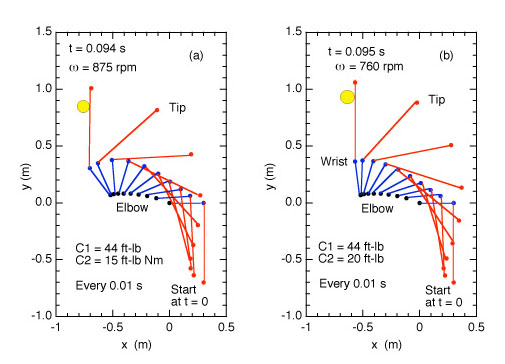
Figure 6 — Positions of the forearm and racquet at intervals of 0.01 s for a serve calculated for a forearm couple C1 = 44 ft-lb and for wrist couples (a) C2 = 15 ft-lb and (b) C2 = 20 ft-lb.
Figure 6 shows two calculations, each for a 300 gram racquet swung by applying a constant forearm couple C1 = 44 ft-lb during the whole serve. The two calculations correspond to two different, constant wrist couples, either 15 ft-lb or 20 ft-lb. The elbow speed was taken from the measured speed shown in Fig. 3. The racquet and the forearm were both assumed to be at rest, not rotating, at the start of the serve. The racquet shown in Fig. 6(a) swung around into a vertical position after 0.094 seconds and was then rotating at 875 rpm. In Fig. 6(b), the racquet swung around into a vertical position after 0.095 seconds and was then rotating at 760 rpm.
At first sight, it might seem like serve (a) is better than serve (b) since the racquet was swinging faster, despite the fact that the wrist couple was actually smaller in (a) than (b). This is a very surprising result. Less wrist action can actually generate a higher serve speed. However, serve (a) is not good since the forearm is inclined too far forward when the racquet arrives in a vertical position. Serve (b) is better since the forearm is inclined only 10 degrees forward, as it was in the first video.
Figure 7 shows the rotation speed of the racquet and the forearm for the two serves in Fig. 6. The serve with the smaller wrist couple allowed the forearm to rotate at a higher speed before the speed started to drop. The bigger drop in forearm speed then generated a larger racquet speed. If a large wrist couple is applied to the racquet early in the serve then it acts back on the forearm and reduces the rotation speed of the forearm. The end result is that the racquet doesn't rotate as fast, but the racquet lines up correctly when the racquet is just slightly in front of the elbow.
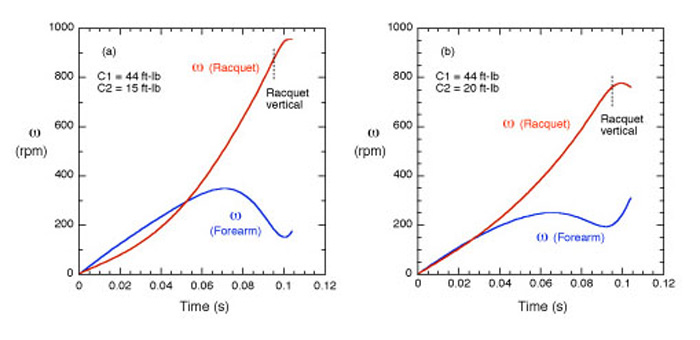
Figure 7 — Rotation speeds of the forearm and racquet for the serves shown in Fig. 6.
There are many different ways of applying wrist and elbow couples in a serve. A large couple could be applied for the first part of the serve and then it could drop to a smaller value or even zero for the remainder of the serve. Or the elbow couple could decrease to zero while the wrist couple increases with time. One such serve is shown in Fig. 8, as an attempt to reproduce the serve in the video film.
Figure 8(a) shows the position of the forearm and racquet at intervals of 0.01 seconds. Figure 8(b) shows the rotation speed of the arm and the racquet vs time and it also shows the couple C1 applied to the forearm and the couple C2 applied to the racquet. The two couples were chosen to give reasonable agreement with the serve in the video film. C1 was held constant at 44 ft-lbs for 0.05 seconds and was then allowed to decrease to zero. C2 was allowed to decrease in time at the start of the serve so that the racquet would remain locked at right angles to the forearm. The wrist was then allowed to relax until t = 0.035 s, at which time the wrist couple was increased to 19 ft-lb.
For the calculations in Fig. 8, the elbow velocity was taken as that in Fig. 3 (but starting at t = 0.05 s in Fig. 3), and the arm and racquet were assumed to be rotating at 13 rad/s at the start of the swing. The resulting serve is very similar to the video serve. The racquet is correctly aligned at t = 0.073 s, is rotating at 880 rpm at that time, and the forearm has slowed almost to a stop at the impact time.
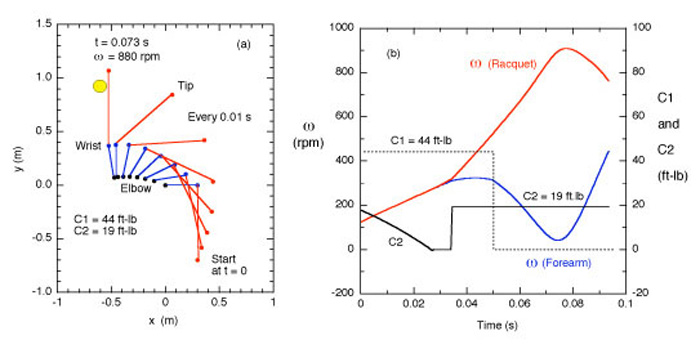
Figure 8 — Calculations for serve shown in video. The rotation speeds are shown in rpm. C1 is the couple applied to the forearm by the elbow and C2 is the couple applied to the racquet by the wrist. The elbow is relaxed when C1 = 0. The wrist is relaxed when C2 = 0.
One thing is clear from Figs. 6 to 8, and that is the server must use the wrist in an active manner. It is possible to relax the wrist briefly in the middle of the serve action, as shown in Fig. 8, but the wrist must be used near the end of the serve to apply a positive couple to the racquet. In that respect, a serve is different from a golf swing where the golfer can relax the wrists after unlocking the wrists. On the other hand, the elbow can relax near the end of a serve, as shown in Fig. 8(b). By relaxing the elbow just before impacting the ball, the forearm slows down more rapidly and transfers its rotational energy to the racquet.
8. A TYPICAL FOREHAND
A forehand in tennis is usually struck with topspin by swinging the racquet upward as well as forward. In order to apply the double pendulum model, we need to ignore vertical motion of the racquet and assume that both the forearm and the racquet swing in a horizontal plane (or perhaps in some other plane inclined to the horizontal). The vertical speed component of the outgoing ball is relatively small unless the player attempts a topspin lob over the opponent's head. Forward motion of the racquet usually commences when the forearm is pointing in a direction approximately toward the back fence and the racquet is about 50 degrees further around. Players don't always commence forward motion of the racquet from that position, but these values are typical.
In a tennis forehand, the ball is normally struck in front of the body with the forearm extended forward while the racquet is aligned nearly parallel to the net at the point of impact. That way, the outgoing ball heads toward the net. This type of swing differs from one in golf or baseball where the wrists remain locked with the forearms at right angles to the club or the bat. Soon after the start of a golf or baseball swing, the wrists relax and the striking implement then rotates rapidly to align with the arms at the point of impact.
A realistic forehand can be modeled by assuming that the couples C1 and C2 remain constant in time. If the wrist remains locked then the forearm and the racquet swing at the same rotational speed at the beginning of the swing, and C2 decreases with time. If C2 remains constant in time then the forearm swings faster than the racquet at the beginning of the stroke, while the racquet swings faster than the forearm toward the end of the stroke. Both types of forehand are relatively common and can be viewed on YouTube and at www.tennisplayer.net.
Calculations for a medium pace forehand are shown in Figs. 9 and 10 for a racquet of length 70 cm, mass 300 g, swing weight 310 kg.cm2 and with a balance point (center of mass) 35 cm from the butt end of the handle. The mass of the forearm was taken as 1.5 kg, and the mass of the hand was taken as 0.5 kg. The racquet was swung with C1 = 25 Nm and C2 = 2.5 Nm, resulting in good alignment of the racquet at the nominal impact point.
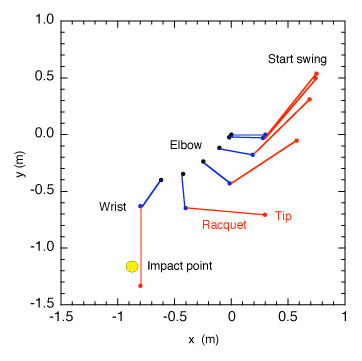
Figure 9 — View from above showing the positions of the elbow, wrist, forearm and racquet at 0.05 s intervals for a 300 g racquet swung in a horizontal plane to impact the ball. The elbow swings forward due to rotation about the shoulder and forward motion of the player.
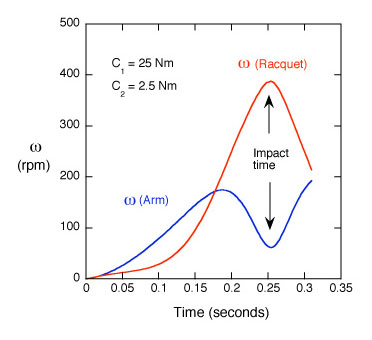
Figure 10 — Angular velocities of the forearm and the racquet for the forehand shown in Fig. 9. After 0.2 seconds, the racquet speeds up rapidly and the forearm slows down.
The angular velocities of the forearm and the racquet are shown in Fig. 10. Despite the fact that C2 was held constant, rotational energy transferred from the arm to the racquet during the swing, with the result that ω1 decreased to a minimum and ω2 increased to a maximum near the end of the swing. Acceleration and deceleration of the elbow simulates the effect of a triple pendulum whereby rotational energy in the upper arm is transferred to the forearm in an analogous manner. In an efficient tennis (or golf or baseball) swing, energy is first transferred from the upper arm to the forearm and is subsequently transferred from the forearm to the racquet after a short time delay.
9. CONCLUSION
In this article we have just scratched the surface in terms of analyzing different tennis strokes and in understanding the subtle interactions between the player and the racquet. We did not consider what might happen if racquet properties are changed and we considered only one forehand stroke. Nevertheless, we have shown that tennis strokes have many similarities to a mechanical double pendulum and have explained how motion of the forearm affects the motion of the racquet, and vice versa, at least in simple situations where the arm and racquet rotate in the same plane. Slow motion video is a powerful tool in analyzing player strokes. It also needs to be combined with a clear understanding of what is being observed and what is happening if players and coaches are to reap maximum benefits by using this tool.

